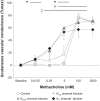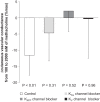K+ channel mechanisms underlying cholinergic cutaneous vasodilation and sweating in young humans: roles of KCa, KATP, and KV channels?
- PMID: 27440718
- PMCID: PMC5142229
- DOI: 10.1152/ajpregu.00249.2016
K+ channel mechanisms underlying cholinergic cutaneous vasodilation and sweating in young humans: roles of KCa, KATP, and KV channels?
Abstract
Acetylcholine released from cholinergic nerves is involved in heat loss responses of cutaneous vasodilation and sweating. K(+) channels are thought to play a role in regulating cholinergic cutaneous vasodilation and sweating, though which K(+) channels are involved in their regulation remains unclear. We evaluated the hypotheses that 1) Ca(2+)-activated K(+) (KCa), ATP-sensitive K(+) (KATP), and voltage-gated K(+) (KV) channels all contribute to cholinergic cutaneous vasodilation; and 2) KV channels, but not KCa and KATP channels, contribute to cholinergic sweating. In 13 young adults (24 ± 5 years), cutaneous vascular conductance (CVC) and sweat rate were evaluated at intradermal microdialysis sites that were continuously perfused with: 1) lactated Ringer (Control), 2) 50 mM tetraethylammonium (KCa channel blocker), 3) 5 mM glybenclamide (KATP channel blocker), and 4) 10 mM 4-aminopyridine (KV channel blocker). At all sites, cholinergic cutaneous vasodilation and sweating were induced by coadministration of methacholine (0.0125, 0.25, 5, 100, and 2,000 mM, each for 25 min). The methacholine-induced increase in CVC was lower with the KCa channel blocker relative to Control at 0.0125 (1 ± 1 vs. 9 ± 6%max) and 5 (2 ± 5 vs. 17 ± 14%max) mM methacholine, whereas it was lower in the presence of KATP (69 ± 7%max) and KV (57 ± 14%max) channel blocker compared with Control (79 ± 6%max) at 100 mM methacholine. Furthermore, methacholine-induced sweating was lower at the KV channel blocker site (0.42 ± 0.17 mg·min(-1)·cm(-2)) compared with Control (0.58 ± 0.15 mg·min(-1)·cm(-2)) at 2,000 mM methacholine. In conclusion, we show that KCa, KATP, and KV channels play a role in cholinergic cutaneous vasodilation, whereas only KV channels contribute to cholinergic sweating in normothermic resting humans.
Keywords: hyperpolarization; potassium channel; sweat secretion; thermoregulation.
Copyright © 2016 the American Physiological Society.
Figures





Similar articles
-
Separate and combined effects of KCa and KATP channel blockade with NOS inhibition on cutaneous vasodilation and sweating in older men during heat stress.Am J Physiol Regul Integr Comp Physiol. 2019 Jul 1;317(1):R113-R120. doi: 10.1152/ajpregu.00075.2019. Epub 2019 May 15. Am J Physiol Regul Integr Comp Physiol. 2019. PMID: 31091157 Free PMC article.
-
The roles of KCa, KATP, and KV channels in regulating cutaneous vasodilation and sweating during exercise in the heat.Am J Physiol Regul Integr Comp Physiol. 2017 May 1;312(5):R821-R827. doi: 10.1152/ajpregu.00507.2016. Epub 2017 Mar 2. Am J Physiol Regul Integr Comp Physiol. 2017. PMID: 28254750 Free PMC article.
-
Mechanisms of nicotine-induced cutaneous vasodilation and sweating in young adults: roles for KCa, KATP, and KV channels, nitric oxide, and prostanoids.Appl Physiol Nutr Metab. 2017 May;42(5):470-478. doi: 10.1139/apnm-2016-0615. Epub 2017 Mar 22. Appl Physiol Nutr Metab. 2017. PMID: 28177721
-
SNAREing voltage-gated K+ and ATP-sensitive K+ channels: tuning beta-cell excitability with syntaxin-1A and other exocytotic proteins.Endocr Rev. 2007 Oct;28(6):653-63. doi: 10.1210/er.2007-0010. Epub 2007 Sep 18. Endocr Rev. 2007. PMID: 17878408 Review.
-
Involvement of C-type inactivation gating in the actions of voltage-gated K+ channel inhibitors.Pharmacol Ther. 2012 Feb;133(2):151-8. doi: 10.1016/j.pharmthera.2011.10.005. Epub 2011 Oct 30. Pharmacol Ther. 2012. PMID: 22074796 Review.
Cited by
-
Elucidating mechanisms of attenuated skin vasodilation during passive heat stress in persons with spinal cord injury.J Spinal Cord Med. 2024 Sep;47(5):765-774. doi: 10.1080/10790268.2023.2203535. Epub 2023 May 9. J Spinal Cord Med. 2024. PMID: 37158753 Free PMC article.
-
Intradermal administration of endothelin-1 attenuates endothelium-dependent and -independent cutaneous vasodilation via Rho kinase in young adults.Am J Physiol Regul Integr Comp Physiol. 2017 Jan 1;312(1):R23-R30. doi: 10.1152/ajpregu.00368.2016. Epub 2016 Nov 23. Am J Physiol Regul Integr Comp Physiol. 2017. PMID: 27881399 Free PMC article.
-
Cerebrovascular effects of glibenclamide investigated using high-resolution magnetic resonance imaging in healthy volunteers.J Cereb Blood Flow Metab. 2021 Jun;41(6):1328-1337. doi: 10.1177/0271678X20959294. Epub 2020 Oct 7. J Cereb Blood Flow Metab. 2021. PMID: 33028147 Free PMC article. Clinical Trial.
-
Separate and combined effects of KCa and KATP channel blockade with NOS inhibition on cutaneous vasodilation and sweating in older men during heat stress.Am J Physiol Regul Integr Comp Physiol. 2019 Jul 1;317(1):R113-R120. doi: 10.1152/ajpregu.00075.2019. Epub 2019 May 15. Am J Physiol Regul Integr Comp Physiol. 2019. PMID: 31091157 Free PMC article.
-
The roles of KCa, KATP, and KV channels in regulating cutaneous vasodilation and sweating during exercise in the heat.Am J Physiol Regul Integr Comp Physiol. 2017 May 1;312(5):R821-R827. doi: 10.1152/ajpregu.00507.2016. Epub 2017 Mar 2. Am J Physiol Regul Integr Comp Physiol. 2017. PMID: 28254750 Free PMC article.
References
-
- Bae H, Lee HJ, Kim K, Kim JH, Kim T, Ko JH, Bang H, Lim I. The stimulating effects of nitric oxide on intermediate conductance Ca2+-activated K+ channels in human dermal fibroblasts through PKG pathways but not the PKA pathways. Chin J Physiol 57: 137–151, 2014. - PubMed
-
- Buono MJ, Gonzalez G, Guest S, Hare A, Numan T, Tabor B, White A. The role of in vivo beta-adrenergic stimulation on sweat production during exercise. Auton Neurosci 155: 91–93, 2010. - PubMed
Publication types
MeSH terms
Substances
LinkOut - more resources
Full Text Sources
Other Literature Sources
Miscellaneous

